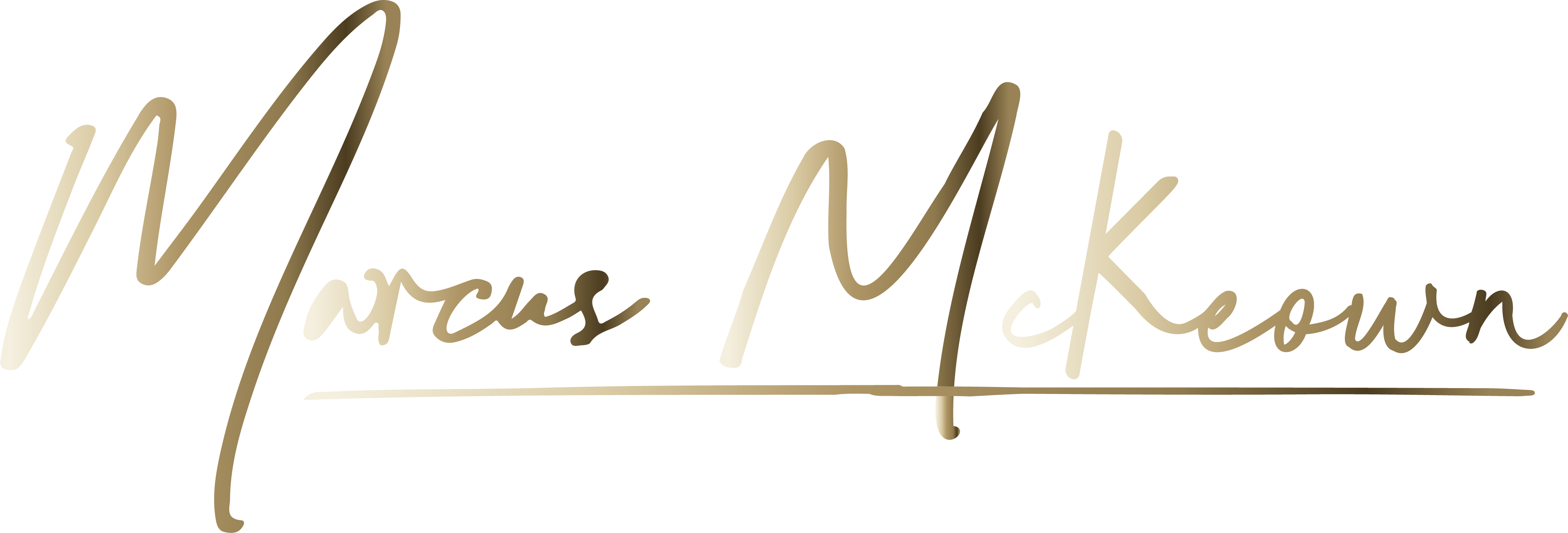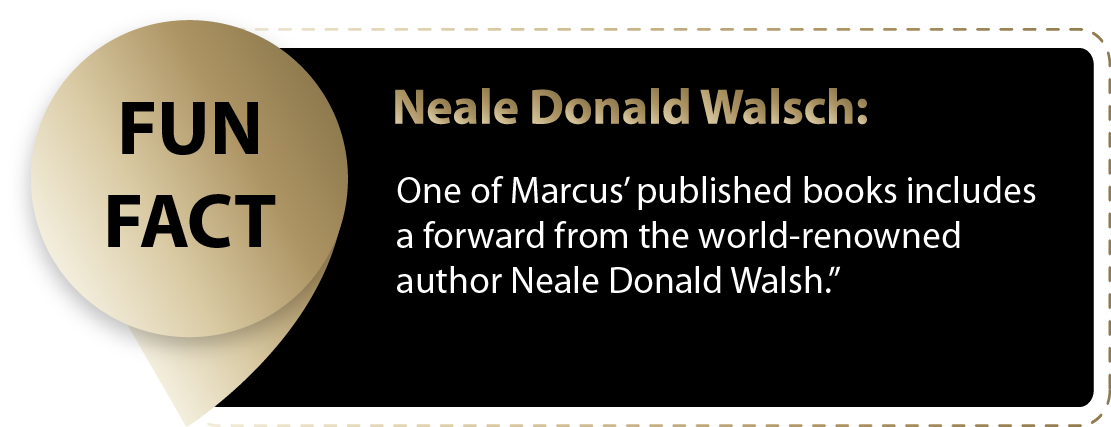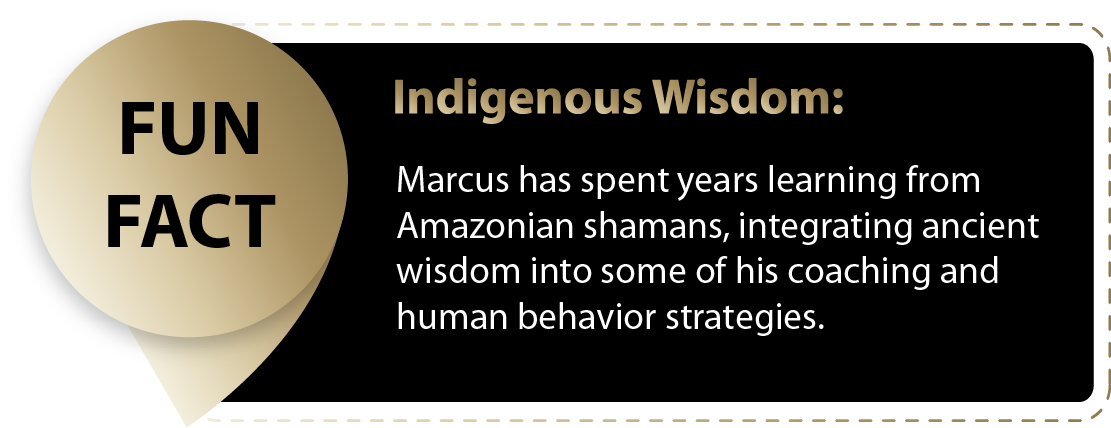

High-Performance Coach, Mediator & Negotiator
Unlock your full potential with one of the most sought-after experts in performance coaching, leadership transformation, mediation & negotiation. With nearly three decades of experience, Marcus McKeown has helped elite professionals, executives & organizations navigate breakthrough change and achieve unparalleled success.
The Architect of Change
Marcus is a globally recognized High-Performance Coach, Mediator & Negotiator. His expertise spans personal and executive coaching, leadership transformation, culture development, marketing & communications and complex conflict resolution. He has worked extensively with C-suite executives, sales & marketing teams, HR teams & organizations undergoing strategic reinvention.








The Architect of Change
Marcus is a globally recognized High-Performance Coach, Mediator & Negotiator. His expertise spans personal and executive coaching, leadership transformation, culture development, marketing & communications and complex conflict resolution. He has worked extensively with C-suite executives, sales & marketing teams, HR teams & organizations undergoing strategic reinvention.
As an author, speaker & visionary, Marcus helps individuals and businesses achieve lasting change by understanding the deeper psychology behind success and failure. His skill-set enables him to go beyond traditional coaching, offering strategic insights that unlock potential, remove resistance & drive transformation.

Commercial Pilot:
Marcus Trained under the FAA, USA & graduated with a commercial Pilots license.


High-Performance Coach, Mediator & Negotiator
Unlock your full potential with one of the most sought-after experts in performance coaching, leadership transformation, mediation & negotiation. With nearly three decades of experience, Marcus McKeown has helped elite professionals, executives & organizations navigate breakthrough change and achieve unparalleled success.

High-Performance Coach, Mediator & Negotiator
Unlock your full potential with one of the most sought-after experts in performance coaching, leadership transformation, mediation & negotiation. With nearly three decades of experience, Marcus McKeown has helped elite professionals, executives & organizations navigate breakthrough change and achieve unparalleled success.

High-Performance Coach, Mediator & Negotiator
Unlock your full potential with one of the most sought-after experts in performance coaching, leadership transformation, mediation & negotiation. With nearly three decades of experience, Marcus McKeown has helped elite professionals, executives & organizations navigate breakthrough change and achieve unparalleled success.
As an author, speaker & visionary, Marcus helps individuals and businesses achieve lasting change by understanding the deeper psychology behind success and failure. His skill-set enables him to go beyond traditional coaching, offering strategic insights that unlock potential, remove resistance & drive transformation.

As an author, speaker & visionary, Marcus helps individuals and businesses achieve lasting change by understanding the deeper psychology behind success and failure. His skill-set enables him to go beyond traditional coaching, offering strategic insights that unlock potential, remove resistance & drive transformation.

Testimonial
Founder & CEO: Digital Insurance Industry
“During the launch of our digital sales channel, Marcus’ coaching played a crucial role in our success. Our sales team not only outperformed our expectations but also surpassed industry benchmarks. His expertise in human behavior, leadership, and sales psychology ensured we maximized our performance. I highly recommend Marcus as a consultant and coach for both personal and team transformation.”
Expertise & Approach
-
Personal Mastery & Self-Discovery
-
Business Transformation & Leadership Excellence
-
Visionary Reinvention & High-Performance Breakthroughs
-
Mediation & Negotiation for Conflict Resolution
-
Organizational Development & Culture Change
-
Coaching People: Enhancing Awareness, Talent & Leadership Mastery, Sales Excellence
-
Coaching Marketing & Communications
-
Development of animations for marketing & sales messages via ‘The Perfect Story Company’. Marcus is the founder & CEO of this creative agency - The Perfect Story Company – He plays a very active role in the creative process from a visionary perspective and has a team of over 30 artists, creators & animators that do their magic to ensure the client gets exactly what they need

Services
Marcus helps individuals and organizations redefine their purpose, optimize their decision-making & accelerate their success. Whether working with high-level executives or teams seeking a breakthrough, his coaching is designed to create long-term transformation.

Personal Mastery Coaching
Helping individuals unlock their true potential and master their decision-making processes.

Executive & Leadership Coaching
Developing next-level leadership capabilities for C-suite and management teams.

Culture & Organizational Change
Coaching that aligns people, processes & performance.

High-Performance Coaching
Driving success through customized programs tailored to high-achievers.

Mentoring & Networking
Guiding professionals through structured strategies for business growth and leadership evolution.

Mediation & Negotiation Services
High-stakes mediation, corporate conflict resolution & strategic deal-making.


Services
Marcus helps individuals and organizations redefine their purpose, optimize their decision-making & accelerate their success. Whether working with high-level executives or teams seeking a breakthrough, his coaching is designed to create long-term transformation.

Personal Mastery Coaching
Helping individuals unlock their true potential and master their decision-making processes.

Executive & Leadership Coaching
Developing next-level leadership capabilities for C-suite and management teams.

Culture & Organizational Change
Coaching that aligns people, processes & performance.

High-Performance Coaching
Driving success through customized programs tailored to high-achievers.

Mentoring & Networking
Guiding professionals through structured strategies for business growth and leadership evolution.

Mediation & Negotiation Services
High-stakes mediation, corporate conflict resolution & strategic deal-making.
Marcus works with clients globally, with a focus on Europe,
the USA & Latin America

Services
Marcus helps individuals and organizations redefine their purpose, optimize their decision-making & accelerate their success. Whether working with high-level executives or teams seeking a breakthrough, his coaching is designed to create long-term transformation.

Personal Mastery Coaching
Helping individuals unlock their true potential and master their decision-making processes.

Executive & Leadership Coaching
Developing next-level leadership capabilities for C-suite and management teams.

Culture & Organizational Change
Coaching that aligns people, processes & performance.

High-Performance Coaching
Driving success through customized programs tailored to high-achievers.

Mentoring & Networking
Guiding professionals through structured strategies for business growth and leadership evolution.

Mediation & Negotiation Services
High-stakes mediation, corporate conflict resolution & strategic deal-making.


Services
Marcus helps individuals and organizations redefine their purpose, optimize their decision-making & accelerate their success. Whether working with high-level executives or teams seeking a breakthrough, his coaching is designed to create long-term transformation.

Personal Mastery Coaching
Helping individuals unlock their true potential and master their decision-making processes.

Executive & Leadership Coaching
Developing next-level leadership capabilities for C-suite and management teams.

Culture & Organizational Change
Coaching that aligns people, processes & performance.

High-Performance Coaching
Driving success through customized programs tailored to high-achievers.

Mentoring & Networking
Guiding professionals through structured strategies for business growth and leadership evolution.

Mediation & Negotiation Services
High-stakes mediation, corporate conflict resolution & strategic deal-making.
Marcus works with clients globally, with a focus on Europe,
the USA & Latin America


Testimonial
Vice President of HR – Leading Bank in USA & Latin America
“Marcus transformed our C-suite, sales, marketing, and HR teams. His strategic approach created a more aligned and high-performing organization, delivering measurable success in leadership and operational efficiency.”
Methodology & Approach
Marcus' coaching and negotiation strategies are built on proprietary frameworks that ensure lasting success:


The ‘Inner Compass Blueprint’
A model designed to help individuals identify their natural flow, eliminate resistance & make powerful, high-level decisions.


The ‘C-Suite Synergy Matrix’
A framework for aligning leadership, vision & execution, ensuring organizations thrive in high-pressure environments.


The ‘Breakthrough Performance Triangle’
A structured approach to achieving transformational change in personal & professional life.


The ‘You Are Your Business’ Framework
This process-driven approach ensures businesses and individuals align their strategy, mindset, and execution for maximum impact.


The ‘Inner Compass Blueprint’
A model designed to help individuals identify their natural flow, eliminate resistance & make powerful, high-level decisions.


The ‘C-Suite Synergy Matrix’
A framework for aligning leadership, vision & execution, ensuring organizations thrive in high-pressure environments.


The ‘Breakthrough Performance Triangle’
A structured approach to achieving transformational change in personal & professional life.


The ‘You Are Your Business’ Framework
This process-driven approach ensures businesses and individuals align their strategy, mindset, and execution for maximum impact.


The ‘Inner Compass Blueprint’
A model designed to help individuals identify their natural flow, eliminate resistance & make powerful, high-level decisions.


The ‘C-Suite Synergy Matrix’
A framework for aligning leadership, vision & execution, ensuring organizations thrive in high-pressure environments.


The ‘Breakthrough Performance Triangle’
A structured approach to achieving transformational change in personal & professional life.


The ‘You Are Your Business’ Framework
This process-driven approach ensures businesses and individuals align their strategy, mindset, and execution for maximum impact.
Each of these models incorporates the latest research in human behavior, decision-making psychology, & organizational development.
Methodology & Approach
Marcus' coaching and negotiation strategies are built on proprietary frameworks that ensure lasting success:
The ‘Inner Compass Blueprint’
A model designed to help individuals identify their natural flow, eliminate resistance & make powerful, high-level decisions.
The ‘C-Suite Synergy Matrix’
A framework for aligning leadership, vision & execution, ensuring organizations thrive in high-pressure environments.
The ‘Breakthrough Performance Triangle’
A structured approach to achieving transformational change in personal & professional life.
The ‘You Are Your Business’ Framework
This process-driven approach ensures businesses and individuals align their strategy, mindset, and execution for maximum impact.
Each of these models incorporates the latest research in human behavior, decision-making psychology, & organizational development.

Testimonial
Senior Executive – World-Leading Medical Devices Company
“Marcus led an organizational development project that included leadership coaching, team alignment training, and workforce motivation for 900 employees. The project resulted in an ROI measured at over 12 times the contract investment, assessed over a three-year period. ROI was evaluated through productivity increases, employee retention, and performance benchmarks, aligned with industry standards for organizational development.”


The ‘Give them what they want, not what they need’ mistake!


The ‘Give them what they want, not what they need’ mistake!

Research Indicates
That clients may not always have a clear understanding of their underlying challenges, leading them to request solutions that address symptoms rather than root causes. By solely focusing on these immediate wants, consultants risk implementing changes that fail to produce meaningful, long-term improvements. This approach can result in client dissatisfaction and a perception of consulting as a superficial exercise.

A More Effective Strategy
Involves consultants taking an active role in diagnosing the fundamental issues clients face, even if these are not initially recognized by the clients themselves. By prioritizing the identification and resolution of core needs over superficial wants, consultants can facilitate genuine transformation and deliver sustainable value.

This Philosophy Aligns
With the principles of high-performance coaching, which emphasize the importance of addressing the psychological aspects of change. Understanding the human factors that influence behavior is crucial for implementing changes that are both effective and enduring.

Incorporating This
Into coaching practices requires a commitment to thorough analysis, open communication and a willingness to challenge clients' initial assumptions. By doing so, consultants can move beyond the limitations of traditional methodologies and foster a more impactful, trust-based relationship with their clients.




In the consulting industry, a prevalent approach involves delivering services that align with clients' expressed desires with the intention of later identifying and addressing their actual needs. However, this method often leads to suboptimal outcomes, as it may perpetuate avoidance behaviors and reinforce traditional, less effective consulting paradigms.

This Philosophy Aligns
With the principles of high-performance coaching, which emphasize the importance of addressing the psychological aspects of change. Understanding the human factors that influence behavior is crucial for implementing changes that are both effective and enduring.

Incorporating This
Into coaching practices requires a commitment to thorough analysis, open communication and a willingness to challenge clients' initial assumptions. By doing so, consultants can move beyond the limitations of traditional methodologies and foster a more impactful, trust-based relationship with their clients.

A More Effective Strategy
Involves consultants taking an active role in diagnosing the fundamental issues clients face, even if these are not initially recognized by the clients themselves. By prioritizing the identification and resolution of core needs over superficial wants, consultants can facilitate genuine transformation and deliver sustainable value.

Research Indicates
That clients may not always have a clear understanding of their underlying challenges, leading them to request solutions that address symptoms rather than root causes. By solely focusing on these immediate wants, consultants risk implementing changes that fail to produce meaningful, long-term improvements. This approach can result in client dissatisfaction and a perception of consulting as a superficial exercise.

Testimonial
Director of Marketing & Communications (CMO) – Electronics Industry
“Marcus was subcontracted through a leading marketing firm to coach our storytelling, vision and execution strategy. His expertise in marketing communications, including animations and brand messaging, was invaluable in delivering a high-impact campaign.”




Are you ready to take yourself, your team, or your business to the next level?
Contact Marcus today to explore how his coaching, mediation, and negotiation expertise can drive your transformation.

